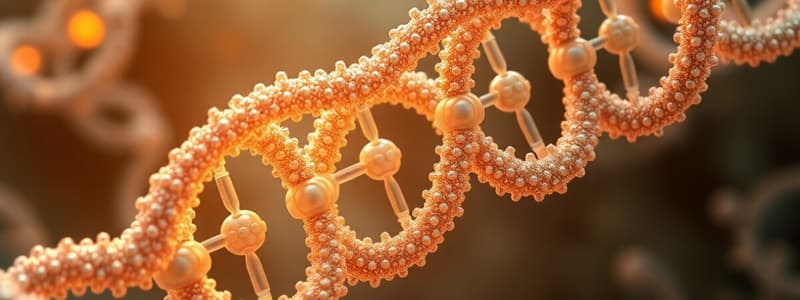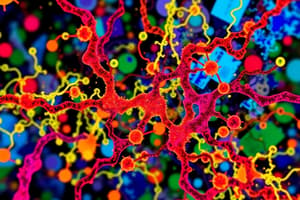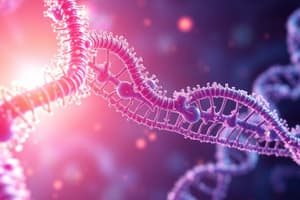Podcast
Questions and Answers
What is the effect of histone deacetylases (HDACs) on chromatin?
What is the effect of histone deacetylases (HDACs) on chromatin?
- They promote condensation of chromatin. (correct)
- They promote decondensation of chromatin.
- They enhance transcriptional activity.
- They interfere with DNA replication.
Which type of chromatin is characterized by being highly condensed?
Which type of chromatin is characterized by being highly condensed?
- Heterochromatin (correct)
- Active chromatin
- Facultative chromatin
- Euchromatin
What role does HP1 play in chromatin structure?
What role does HP1 play in chromatin structure?
- It prevents chromatin condensation.
- It binds to trimethylated lysine 9 on histone H3. (correct)
- It promotes deacetylation of histones.
- It inhibits histone methylation.
What is associated with transcriptionally active chromatin?
What is associated with transcriptionally active chromatin?
What does the term 'histone code' refer to?
What does the term 'histone code' refer to?
Which kind of DNA modification is not part of epigenetics?
Which kind of DNA modification is not part of epigenetics?
How does boundary element function in chromatin?
How does boundary element function in chromatin?
What modification is characteristic of euchromatin?
What modification is characteristic of euchromatin?
What is the function of the left LTR in the retroviral life cycle?
What is the function of the left LTR in the retroviral life cycle?
Which enzyme synthesizes the dsDNA in retroviral replication?
Which enzyme synthesizes the dsDNA in retroviral replication?
What are endogenous retroviruses (ERVs) primarily comprised of?
What are endogenous retroviruses (ERVs) primarily comprised of?
What type of DNA comprises approximately 6% of the human genome?
What type of DNA comprises approximately 6% of the human genome?
Which of the following statements about nonviral retrotransposons is true?
Which of the following statements about nonviral retrotransposons is true?
In the human genome, what percentage of genomic DNA is transcribed into pre-mRNA precursors?
In the human genome, what percentage of genomic DNA is transcribed into pre-mRNA precursors?
What percentage of the human genome is comprised of LINEs?
What percentage of the human genome is comprised of LINEs?
Which of the following describes the length range of introns in human DNA?
Which of the following describes the length range of introns in human DNA?
Which LINE is the most common element found in the human genome?
Which LINE is the most common element found in the human genome?
What is the significance of the A/T rich region in LINEs?
What is the significance of the A/T rich region in LINEs?
What is the typical length range of human exons?
What is the typical length range of human exons?
What type of DNA consists of short sequences repeated in long tandem arrays and is found at specific chromosome locations?
What type of DNA consists of short sequences repeated in long tandem arrays and is found at specific chromosome locations?
How many copies of SINEs are typically found in the human genome?
How many copies of SINEs are typically found in the human genome?
Which of the following types of DNA is known for its variations in length and includes segments that are often many kilobases long?
Which of the following types of DNA is known for its variations in length and includes segments that are often many kilobases long?
What is the primary reason for the lack of a consistent relationship between DNA amount and phylogenetic complexity among eukaryotes?
What is the primary reason for the lack of a consistent relationship between DNA amount and phylogenetic complexity among eukaryotes?
What is commonly implicated in neuromuscular diseases due to expanded segments?
What is commonly implicated in neuromuscular diseases due to expanded segments?
In mammals, where do the majority of mitochondria in the embryo come from?
In mammals, where do the majority of mitochondria in the embryo come from?
What is the inheritance pattern of mitochondrial DNA in mice?
What is the inheritance pattern of mitochondrial DNA in mice?
What causes the degenerative optic nerve condition in Leber's hereditary optic neuropathy?
What causes the degenerative optic nerve condition in Leber's hereditary optic neuropathy?
What is heteroplasmy in the context of mtDNA?
What is heteroplasmy in the context of mtDNA?
Which of the following describes petite mitochondria?
Which of the following describes petite mitochondria?
Which statement is true about mitochondrial genetic codes?
Which statement is true about mitochondrial genetic codes?
What mainly encodes proteins in chloroplasts?
What mainly encodes proteins in chloroplasts?
What is the typical size range of cpDNA in chloroplasts?
What is the typical size range of cpDNA in chloroplasts?
What is a gene defined as in terms of nucleic acid sequence?
What is a gene defined as in terms of nucleic acid sequence?
Which of the following is NOT a component of nuclear eukaryotic DNA?
Which of the following is NOT a component of nuclear eukaryotic DNA?
What does the term 'histone code' refer to?
What does the term 'histone code' refer to?
Which aspect of chromatin structure is primarily affected by histone tail modifications?
Which aspect of chromatin structure is primarily affected by histone tail modifications?
Which of the following best contrasts prokaryotic and eukaryotic gene structure?
Which of the following best contrasts prokaryotic and eukaryotic gene structure?
Which classes of DNA are found in eukaryotic nuclei?
Which classes of DNA are found in eukaryotic nuclei?
What role do transposons play in DNA?
What role do transposons play in DNA?
Which of these statements regarding organelle DNA is true?
Which of these statements regarding organelle DNA is true?
What is the primary function of the coding region of a gene?
What is the primary function of the coding region of a gene?
In prokaryotes, what characterizes an operon?
In prokaryotes, what characterizes an operon?
What is a key characteristic of eukaryotic genes compared to prokaryotic genes?
What is a key characteristic of eukaryotic genes compared to prokaryotic genes?
What role do splice sites play in complex transcriptional units in eukaryotic genes?
What role do splice sites play in complex transcriptional units in eukaryotic genes?
What is one major difference between monocistronic and polycistronic mRNAs?
What is one major difference between monocistronic and polycistronic mRNAs?
Which of the following regions in eukaryotic genes often requires processing to create multiple mRNA variants?
Which of the following regions in eukaryotic genes often requires processing to create multiple mRNA variants?
Which of the following components are commonly found in eukaryotic genes but absent in prokaryotic genes?
Which of the following components are commonly found in eukaryotic genes but absent in prokaryotic genes?
What is the transcriptional-control region primarily responsible for?
What is the transcriptional-control region primarily responsible for?
Flashcards
Histone tails
Histone tails
The 'tails' of histone proteins, which extend out from the core histone octamer and can be chemically modified.
Heterochromatin
Heterochromatin
Highly condensed chromatin, usually inactive.
Euchromatin
Euchromatin
Less condensed chromatin, generally active in transcription.
Histone Deacetylases (HDACs)
Histone Deacetylases (HDACs)
Signup and view all the flashcards
Histone methylation
Histone methylation
Signup and view all the flashcards
Chromatin condensation
Chromatin condensation
Signup and view all the flashcards
Chromodomain
Chromodomain
Signup and view all the flashcards
Heterochromatin Protein 1 (HP1)
Heterochromatin Protein 1 (HP1)
Signup and view all the flashcards
Boundary elements
Boundary elements
Signup and view all the flashcards
Bromodomains
Bromodomains
Signup and view all the flashcards
Epigenetics
Epigenetics
Signup and view all the flashcards
Histone code
Histone code
Signup and view all the flashcards
Gene
Gene
Signup and view all the flashcards
Prokaryotic Gene Structure
Prokaryotic Gene Structure
Signup and view all the flashcards
Eukaryotic Gene Structure
Eukaryotic Gene Structure
Signup and view all the flashcards
Coding DNA
Coding DNA
Signup and view all the flashcards
Noncoding DNA
Noncoding DNA
Signup and view all the flashcards
Exons
Exons
Signup and view all the flashcards
Introns
Introns
Signup and view all the flashcards
Chromatin
Chromatin
Signup and view all the flashcards
Chromosomes
Chromosomes
Signup and view all the flashcards
Histone Code
Histone Code
Signup and view all the flashcards
Genomics
Genomics
Signup and view all the flashcards
Paralogs
Paralogs
Signup and view all the flashcards
Orthologs
Orthologs
Signup and view all the flashcards
Epigenetics
Epigenetics
Signup and view all the flashcards
Gene definition
Gene definition
Signup and view all the flashcards
Coding region
Coding region
Signup and view all the flashcards
Transcriptional control region
Transcriptional control region
Signup and view all the flashcards
Prokaryotic Gene Structure
Prokaryotic Gene Structure
Signup and view all the flashcards
Eukaryotic Gene Structure
Eukaryotic Gene Structure
Signup and view all the flashcards
Operon
Operon
Signup and view all the flashcards
Monocistronic mRNA
Monocistronic mRNA
Signup and view all the flashcards
Polycistronic mRNA
Polycistronic mRNA
Signup and view all the flashcards
Introns
Introns
Signup and view all the flashcards
Exons
Exons
Signup and view all the flashcards
Noncoding DNA
Noncoding DNA
Signup and view all the flashcards
Eukaryotic DNA variation
Eukaryotic DNA variation
Signup and view all the flashcards
Exon length
Exon length
Signup and view all the flashcards
Intron length
Intron length
Signup and view all the flashcards
Pre-mRNA processing
Pre-mRNA processing
Signup and view all the flashcards
Repetitious DNA
Repetitious DNA
Signup and view all the flashcards
Simple-sequence DNA
Simple-sequence DNA
Signup and view all the flashcards
Satellite DNA
Satellite DNA
Signup and view all the flashcards
Microsatellites
Microsatellites
Signup and view all the flashcards
Expanded microsatellites
Expanded microsatellites
Signup and view all the flashcards
Mitochondrial Inheritance
Mitochondrial Inheritance
Signup and view all the flashcards
mtDNA
mtDNA
Signup and view all the flashcards
Heteroplasmy
Heteroplasmy
Signup and view all the flashcards
Leber's Hereditary Optic Neuropathy
Leber's Hereditary Optic Neuropathy
Signup and view all the flashcards
Cytoplasmic Inheritance
Cytoplasmic Inheritance
Signup and view all the flashcards
Petite Mitochondria
Petite Mitochondria
Signup and view all the flashcards
Chloroplast DNA (cpDNA)
Chloroplast DNA (cpDNA)
Signup and view all the flashcards
Photosynthesis
Photosynthesis
Signup and view all the flashcards
Retroviral LTR Promoter
Retroviral LTR Promoter
Signup and view all the flashcards
Retroviral LTR Processing
Retroviral LTR Processing
Signup and view all the flashcards
Retroviral Reverse Transcription
Retroviral Reverse Transcription
Signup and view all the flashcards
Retroviral Integration
Retroviral Integration
Signup and view all the flashcards
Endogenous Retrovirus (ERV)
Endogenous Retrovirus (ERV)
Signup and view all the flashcards
Nonviral Retrotransposons
Nonviral Retrotransposons
Signup and view all the flashcards
Long Interspersed Elements (LINEs)
Long Interspersed Elements (LINEs)
Signup and view all the flashcards
Short Interspersed Elements (SINEs)
Short Interspersed Elements (SINEs)
Signup and view all the flashcards
L1 Retrotransposons
L1 Retrotransposons
Signup and view all the flashcards
Study Notes
Genes, Chromatin, and Chromosomes
- A gene is the complete nucleic acid sequence needed for a functional gene product (polypeptide or RNA).
- Eukaryotic genes contain coding regions (for amino acids/RNA) and transcriptional control regions (promoters).
- Prokaryotic genes often occur in operons, which are single transcriptional units for related functions.
- Eukaryotic genes are typically monocistronic, meaning one mRNA codes for one protein. They also frequently contain introns.
- The human genome is approximately 96% similar to the genomes of the greater apes.
Eukaryotic Gene Structure
- Genes are DNA containing regions coding for RNA molecules (e.g., tRNA, rRNA).
- Eukaryotic genes have coding regions interspersed with non-coding DNA; genes may contain many non-coding DNA regions.
- Eukaryotic genes contain exons (coding regions) and introns (non-coding regions).
- Introns are removed during mRNA processing.
- Different forms of Transcriptional units yield various mRNAs from a single gene.
Prokaryotic Genes
- Prokaryotic genes often produce polycistronic mRNAs, meaning one mRNA can code for multiple proteins.
- Prokaryotic mRNAs lack introns.
- Operons control gene expression in prokaryotes.
Gene Families
- Gene families are sets of duplicated genes with similar sequences.
- Paralogs are genes within the same species that arose from duplication events.
- Orthologs are genes in different species that arose from a common ancestor.
- Duplicated genes arose via gene duplication.
Noncoding DNA
- Much of eukaryotic genomes consists of non-coding DNA.
- Intergenic regions are stretches of DNA between genes.
- Simple-sequence DNA is composed of repeated short sequences.
- Repetitive DNA is a significant portion of eukaryotic genomes.
Transposable Elements
- Transposable elements, or transposons, are DNA sequences that can change position within a genome.
- Two types of transposons: DNA transposons and retrotransposons.
- DNA transposons move directly as DNA.
- Retrotransposons are transcribed into RNA, then reverse transcribed to DNA before moving.
- Transposons sometimes cause mutations.
- LINEs and SINEs are types of retrotransposons.
Chromosomal Organization of Genes
- Density of genes varies across a chromosome.
- Human exon sequences comprise about 2% of the genome.
- Gene copying events produce similar genes.
- Intergenic regions often contain regulatory elements.
Variation Between Individuals
- Single nucleotide polymorphisms (SNPs) account for ~1-2% of genomic differences between diverse human individuals.
- These variations frequently occur in non-coding regions.
- Deletion and duplication events alter gene copy numbers.
Eukaryotic Chromosomes
- Chromosomes are composed of chromatin, which is a complex of DNA and proteins (histones).
- Nucleosomes are DNA-protein complexes with a characteristic “beads-on-a-string” structure.
- Histone tails are subject to modifications (e.g., methylation, acetylation).
- Euchromatin is less condensed, while heterochromatin is more compact.
- Interphase chromosomes are less tightly compacted.
- Metaphase chromosomes are most tightly compacted (typically observed in microscopic cells).
- Nonhistone proteins constitute up to half of the chromosomal mass.
- Chromosome structures are organized by banding (e.g., Giemsa staining).
Genomics
- Genomics is the study of complete genomes.
- Genomic analyses include comparative genome sequencing and analysis, and identifying and characterizing genes.
- Databases, such as GenBank for sequence information, are important resources in genomics.
Organelle DNAs
- Mitochondrial DNA and chloroplast DNA have different characteristics.
- Mitochondrial DNA (mtDNA) has non-coding regions.
- mtDNA is involved in energy production
- mtDNA is inherited primarily from the mother.
- Chloroplast DNAs are often circular.
Studying That Suits You
Use AI to generate personalized quizzes and flashcards to suit your learning preferences.




